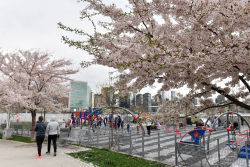Hunter's Point South Park
Hunter's Point South Park
Hunter’s Point Park South is named after the Hunter family, who ran the property as a 210-acre farm. In 1643, New Amsterdam granted Dominie Everadus Bogardus (1609-1647), the Dutch Reformed Minister of the city, property along Newton Creek and the East River. Known as Dominie's Hook, the property was turned over to the British in 1664, and eventually came under British sea captain, George Hunter. The property was renamed Hunter’s Point in 1825.
When the Hunters passed away in 1833, the land was sold and ultimately razed for residential and commercial development. In 1861, a ferry connected Manhattan to Hunter’s Point, and by 1869, farmland in Long Island City came to a halt due to increased immigration and industrialization. The completion of the Queensboro Bridge 1912 brought further manufacturing companies to the area, which led to a concentration of hazardous industries around Hunter’s Point. By the late 20th century the city’s economy changed, leaving industrial buildings unused.
In 1990, the city identified Long Island City’s waterfront for mixed-use development, including residential housing and a new public park. The development of seven parcels was a multi-agency approach to neighborhood planning intended to revitalize a long-underused area of Queens. This monumental project was implemented in phases.
The first phase of Hunter’s Point South Park opened in 2013 and transformed the previously abandoned site with a central green, playground, and waterside promenade. A 13,000-square-foot pavilion houses public restrooms, concessions, and an elevated café plaza. The second phase of park construction opened in 2018 and most notably included 1.5-acres of newly established wetlands and a 30-foot-high cantilevered platform offering unparalleled views of the Manhattan skyline and East River.
The park’s design is complemented by two permanent public artworks. Karyn Olivier's Tether Ball Monument pays homage to the disappearing playground game. Luminescence, an art installation by Nobuho Nagasawa presents the phases of the moon in 6-foot concrete domes that glow at night. Etched to reflect the moon's craters, mountains, and valleys, the permanent sculptures create a natural vista on the park’s landscaped peninsula.
As Long Island City continues to develop, Hunter’s Point South Park has become a jewel in Queens’ collection of city parks.
Check out your park's Vital Signs
Clean & Safe
Green & Resilient
Empowered & Engaged Users
Share your feedback or learn more about how this park is part of a
Vital Park System











